Exploring the Prospects and Limitations of Intercultural Communication
VerifiedAdded on 2020/05/08
|6
|1572
|199
Essay
AI Summary
The essay examines the role of intercultural communication in fostering economic and social development. It highlights potential benefits such as enhanced global trade, cultural exchange, and democratic expansion. Conversely, it identifies limitations including language barriers, ethnocentrism, and media portrayal issues that hinder effective cross-cultural interactions. The paper concludes by advocating for cultural awareness education to overcome these challenges.
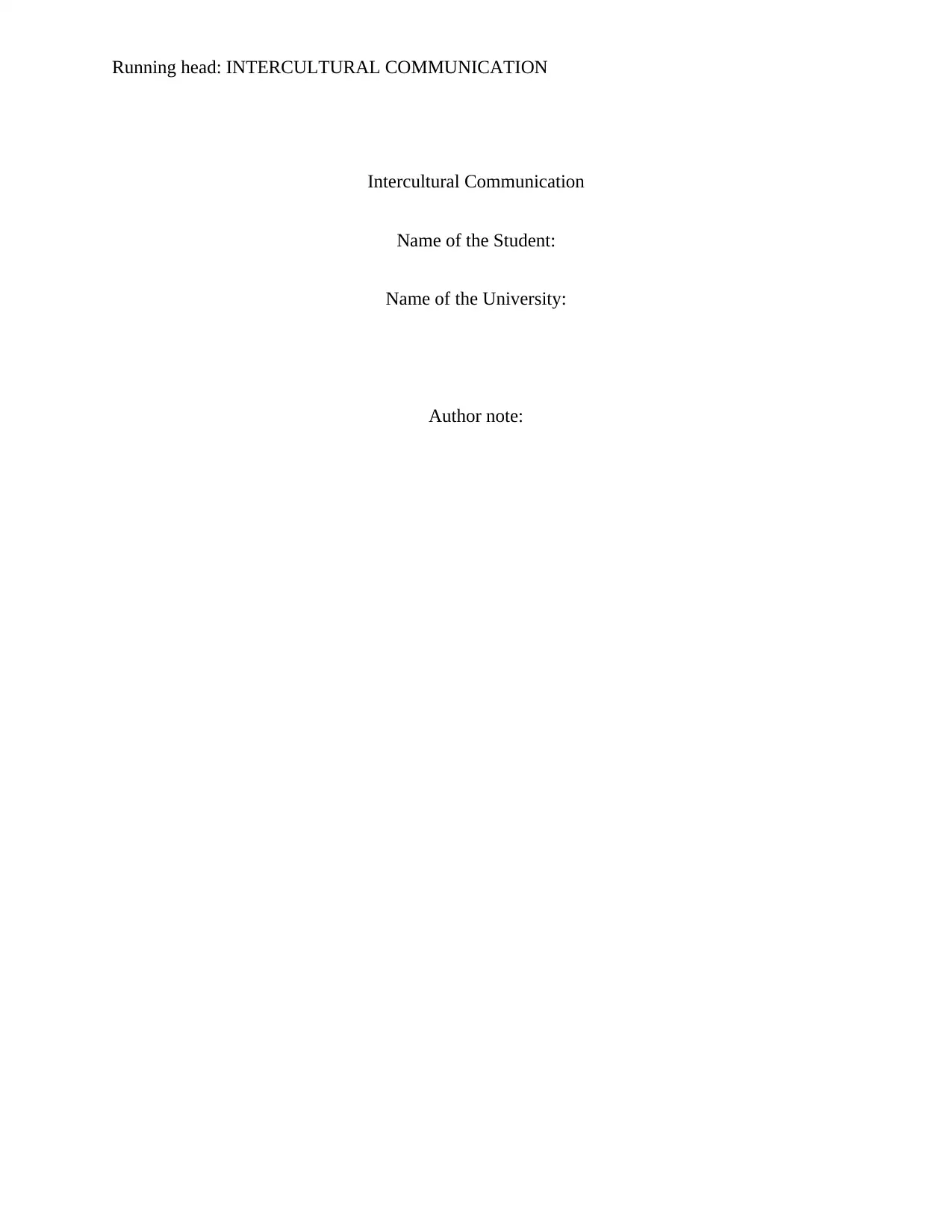
Running head: INTERCULTURAL COMMUNICATION
Intercultural Communication
Name of the Student:
Name of the University:
Author note:
Intercultural Communication
Name of the Student:
Name of the University:
Author note:
Paraphrase This Document
Need a fresh take? Get an instant paraphrase of this document with our AI Paraphraser
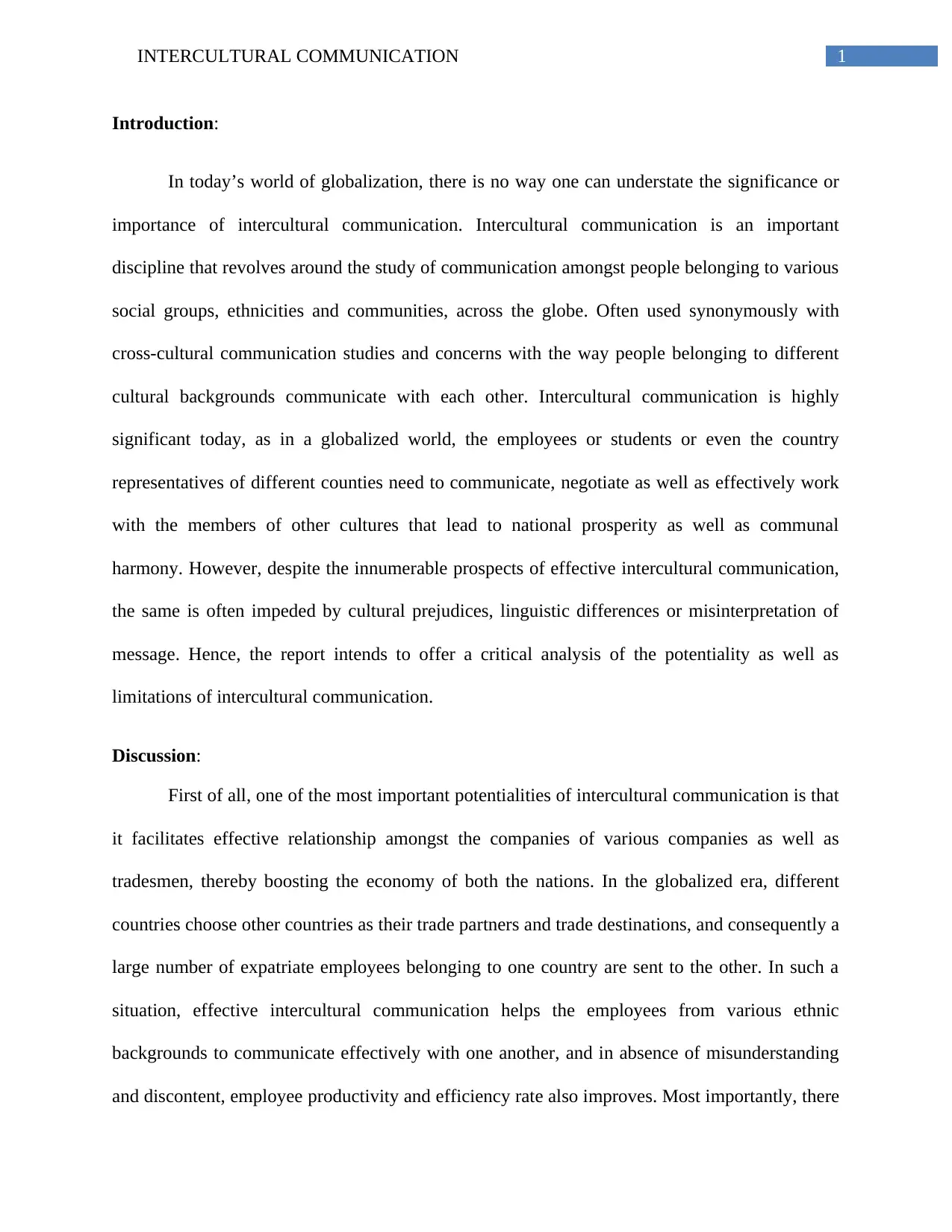
1INTERCULTURAL COMMUNICATION
Introduction:
In today’s world of globalization, there is no way one can understate the significance or
importance of intercultural communication. Intercultural communication is an important
discipline that revolves around the study of communication amongst people belonging to various
social groups, ethnicities and communities, across the globe. Often used synonymously with
cross-cultural communication studies and concerns with the way people belonging to different
cultural backgrounds communicate with each other. Intercultural communication is highly
significant today, as in a globalized world, the employees or students or even the country
representatives of different counties need to communicate, negotiate as well as effectively work
with the members of other cultures that lead to national prosperity as well as communal
harmony. However, despite the innumerable prospects of effective intercultural communication,
the same is often impeded by cultural prejudices, linguistic differences or misinterpretation of
message. Hence, the report intends to offer a critical analysis of the potentiality as well as
limitations of intercultural communication.
Discussion:
First of all, one of the most important potentialities of intercultural communication is that
it facilitates effective relationship amongst the companies of various companies as well as
tradesmen, thereby boosting the economy of both the nations. In the globalized era, different
countries choose other countries as their trade partners and trade destinations, and consequently a
large number of expatriate employees belonging to one country are sent to the other. In such a
situation, effective intercultural communication helps the employees from various ethnic
backgrounds to communicate effectively with one another, and in absence of misunderstanding
and discontent, employee productivity and efficiency rate also improves. Most importantly, there
Introduction:
In today’s world of globalization, there is no way one can understate the significance or
importance of intercultural communication. Intercultural communication is an important
discipline that revolves around the study of communication amongst people belonging to various
social groups, ethnicities and communities, across the globe. Often used synonymously with
cross-cultural communication studies and concerns with the way people belonging to different
cultural backgrounds communicate with each other. Intercultural communication is highly
significant today, as in a globalized world, the employees or students or even the country
representatives of different counties need to communicate, negotiate as well as effectively work
with the members of other cultures that lead to national prosperity as well as communal
harmony. However, despite the innumerable prospects of effective intercultural communication,
the same is often impeded by cultural prejudices, linguistic differences or misinterpretation of
message. Hence, the report intends to offer a critical analysis of the potentiality as well as
limitations of intercultural communication.
Discussion:
First of all, one of the most important potentialities of intercultural communication is that
it facilitates effective relationship amongst the companies of various companies as well as
tradesmen, thereby boosting the economy of both the nations. In the globalized era, different
countries choose other countries as their trade partners and trade destinations, and consequently a
large number of expatriate employees belonging to one country are sent to the other. In such a
situation, effective intercultural communication helps the employees from various ethnic
backgrounds to communicate effectively with one another, and in absence of misunderstanding
and discontent, employee productivity and efficiency rate also improves. Most importantly, there
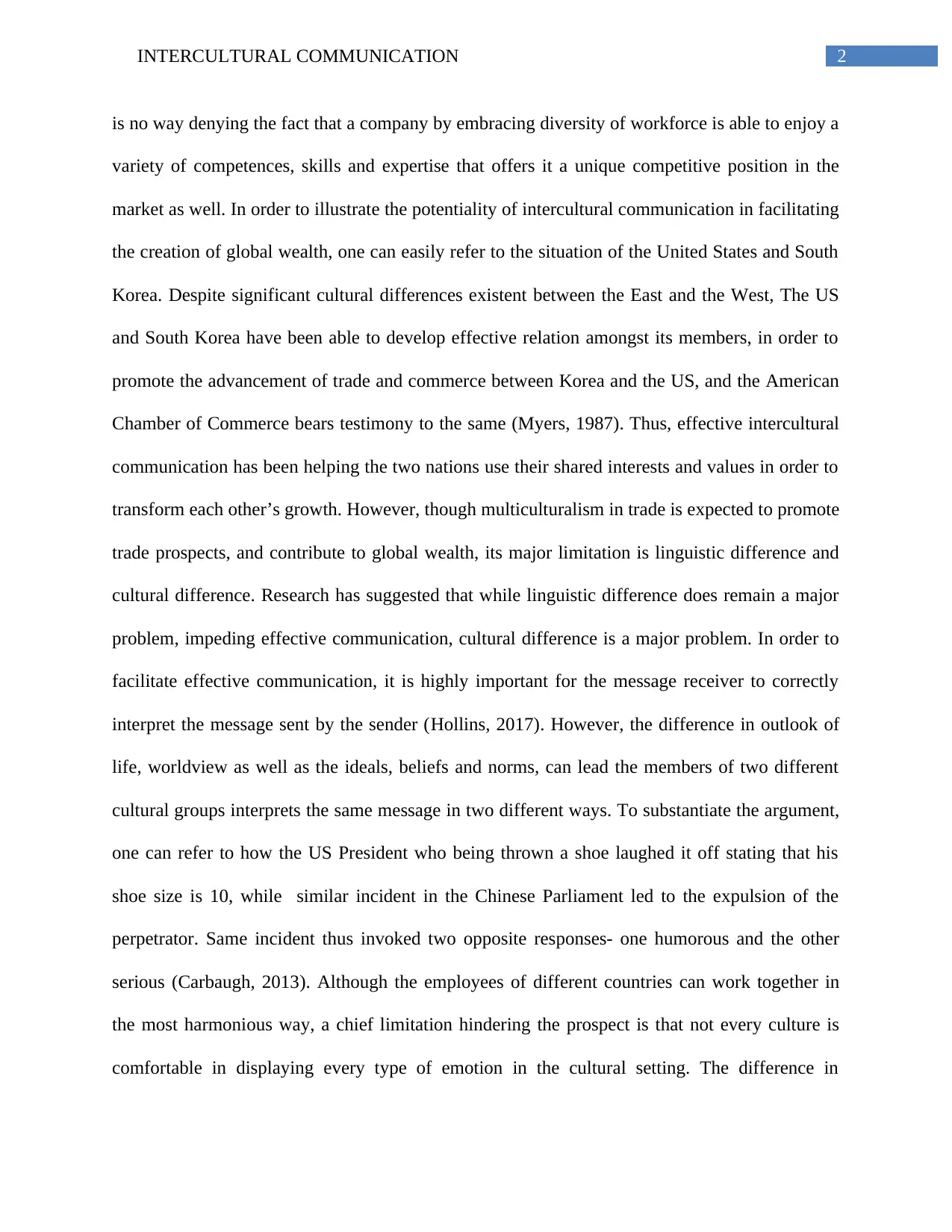
2INTERCULTURAL COMMUNICATION
is no way denying the fact that a company by embracing diversity of workforce is able to enjoy a
variety of competences, skills and expertise that offers it a unique competitive position in the
market as well. In order to illustrate the potentiality of intercultural communication in facilitating
the creation of global wealth, one can easily refer to the situation of the United States and South
Korea. Despite significant cultural differences existent between the East and the West, The US
and South Korea have been able to develop effective relation amongst its members, in order to
promote the advancement of trade and commerce between Korea and the US, and the American
Chamber of Commerce bears testimony to the same (Myers, 1987). Thus, effective intercultural
communication has been helping the two nations use their shared interests and values in order to
transform each other’s growth. However, though multiculturalism in trade is expected to promote
trade prospects, and contribute to global wealth, its major limitation is linguistic difference and
cultural difference. Research has suggested that while linguistic difference does remain a major
problem, impeding effective communication, cultural difference is a major problem. In order to
facilitate effective communication, it is highly important for the message receiver to correctly
interpret the message sent by the sender (Hollins, 2017). However, the difference in outlook of
life, worldview as well as the ideals, beliefs and norms, can lead the members of two different
cultural groups interprets the same message in two different ways. To substantiate the argument,
one can refer to how the US President who being thrown a shoe laughed it off stating that his
shoe size is 10, while similar incident in the Chinese Parliament led to the expulsion of the
perpetrator. Same incident thus invoked two opposite responses- one humorous and the other
serious (Carbaugh, 2013). Although the employees of different countries can work together in
the most harmonious way, a chief limitation hindering the prospect is that not every culture is
comfortable in displaying every type of emotion in the cultural setting. The difference in
is no way denying the fact that a company by embracing diversity of workforce is able to enjoy a
variety of competences, skills and expertise that offers it a unique competitive position in the
market as well. In order to illustrate the potentiality of intercultural communication in facilitating
the creation of global wealth, one can easily refer to the situation of the United States and South
Korea. Despite significant cultural differences existent between the East and the West, The US
and South Korea have been able to develop effective relation amongst its members, in order to
promote the advancement of trade and commerce between Korea and the US, and the American
Chamber of Commerce bears testimony to the same (Myers, 1987). Thus, effective intercultural
communication has been helping the two nations use their shared interests and values in order to
transform each other’s growth. However, though multiculturalism in trade is expected to promote
trade prospects, and contribute to global wealth, its major limitation is linguistic difference and
cultural difference. Research has suggested that while linguistic difference does remain a major
problem, impeding effective communication, cultural difference is a major problem. In order to
facilitate effective communication, it is highly important for the message receiver to correctly
interpret the message sent by the sender (Hollins, 2017). However, the difference in outlook of
life, worldview as well as the ideals, beliefs and norms, can lead the members of two different
cultural groups interprets the same message in two different ways. To substantiate the argument,
one can refer to how the US President who being thrown a shoe laughed it off stating that his
shoe size is 10, while similar incident in the Chinese Parliament led to the expulsion of the
perpetrator. Same incident thus invoked two opposite responses- one humorous and the other
serious (Carbaugh, 2013). Although the employees of different countries can work together in
the most harmonious way, a chief limitation hindering the prospect is that not every culture is
comfortable in displaying every type of emotion in the cultural setting. The difference in
⊘ This is a preview!⊘
Do you want full access?
Subscribe today to unlock all pages.

Trusted by 1+ million students worldwide
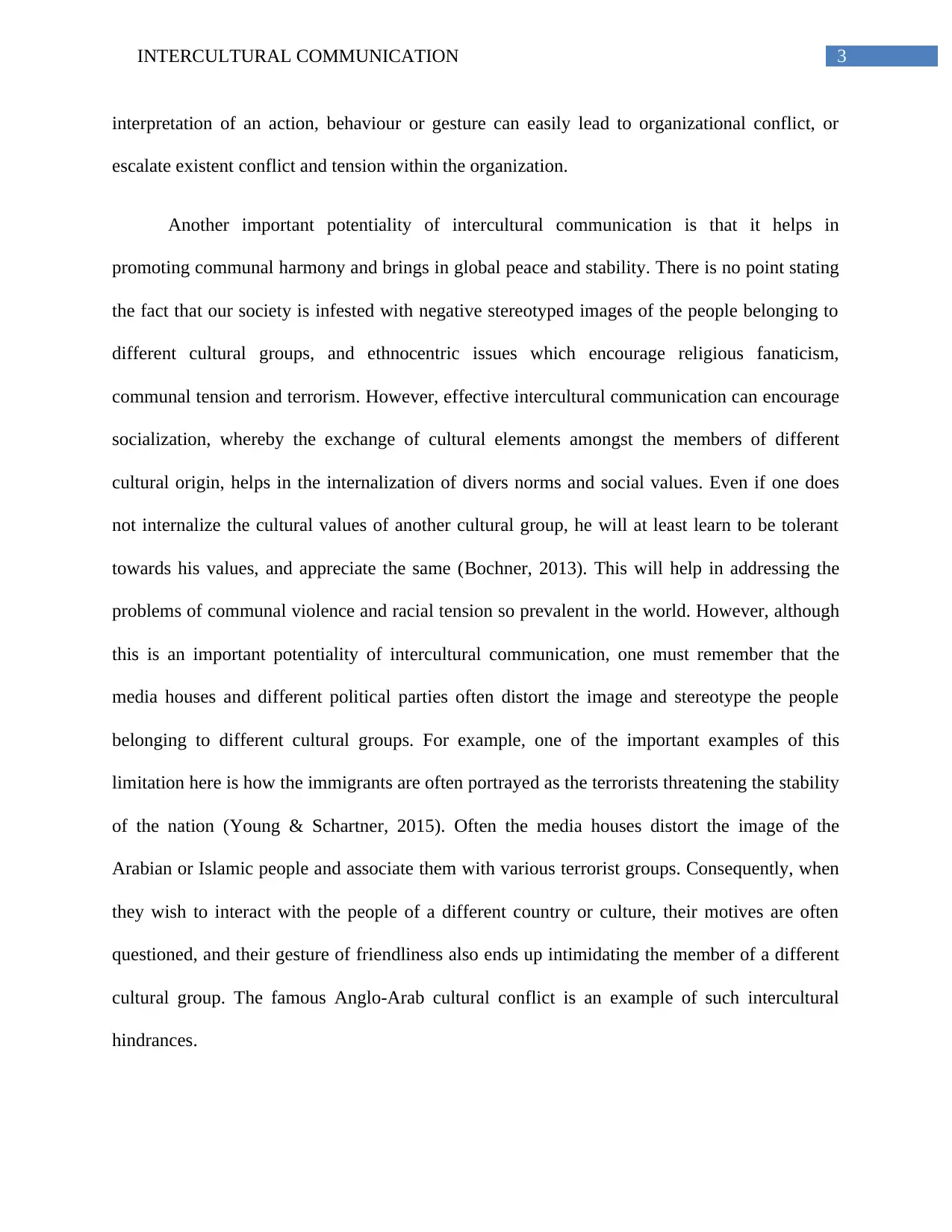
3INTERCULTURAL COMMUNICATION
interpretation of an action, behaviour or gesture can easily lead to organizational conflict, or
escalate existent conflict and tension within the organization.
Another important potentiality of intercultural communication is that it helps in
promoting communal harmony and brings in global peace and stability. There is no point stating
the fact that our society is infested with negative stereotyped images of the people belonging to
different cultural groups, and ethnocentric issues which encourage religious fanaticism,
communal tension and terrorism. However, effective intercultural communication can encourage
socialization, whereby the exchange of cultural elements amongst the members of different
cultural origin, helps in the internalization of divers norms and social values. Even if one does
not internalize the cultural values of another cultural group, he will at least learn to be tolerant
towards his values, and appreciate the same (Bochner, 2013). This will help in addressing the
problems of communal violence and racial tension so prevalent in the world. However, although
this is an important potentiality of intercultural communication, one must remember that the
media houses and different political parties often distort the image and stereotype the people
belonging to different cultural groups. For example, one of the important examples of this
limitation here is how the immigrants are often portrayed as the terrorists threatening the stability
of the nation (Young & Schartner, 2015). Often the media houses distort the image of the
Arabian or Islamic people and associate them with various terrorist groups. Consequently, when
they wish to interact with the people of a different country or culture, their motives are often
questioned, and their gesture of friendliness also ends up intimidating the member of a different
cultural group. The famous Anglo-Arab cultural conflict is an example of such intercultural
hindrances.
interpretation of an action, behaviour or gesture can easily lead to organizational conflict, or
escalate existent conflict and tension within the organization.
Another important potentiality of intercultural communication is that it helps in
promoting communal harmony and brings in global peace and stability. There is no point stating
the fact that our society is infested with negative stereotyped images of the people belonging to
different cultural groups, and ethnocentric issues which encourage religious fanaticism,
communal tension and terrorism. However, effective intercultural communication can encourage
socialization, whereby the exchange of cultural elements amongst the members of different
cultural origin, helps in the internalization of divers norms and social values. Even if one does
not internalize the cultural values of another cultural group, he will at least learn to be tolerant
towards his values, and appreciate the same (Bochner, 2013). This will help in addressing the
problems of communal violence and racial tension so prevalent in the world. However, although
this is an important potentiality of intercultural communication, one must remember that the
media houses and different political parties often distort the image and stereotype the people
belonging to different cultural groups. For example, one of the important examples of this
limitation here is how the immigrants are often portrayed as the terrorists threatening the stability
of the nation (Young & Schartner, 2015). Often the media houses distort the image of the
Arabian or Islamic people and associate them with various terrorist groups. Consequently, when
they wish to interact with the people of a different country or culture, their motives are often
questioned, and their gesture of friendliness also ends up intimidating the member of a different
cultural group. The famous Anglo-Arab cultural conflict is an example of such intercultural
hindrances.
Paraphrase This Document
Need a fresh take? Get an instant paraphrase of this document with our AI Paraphraser
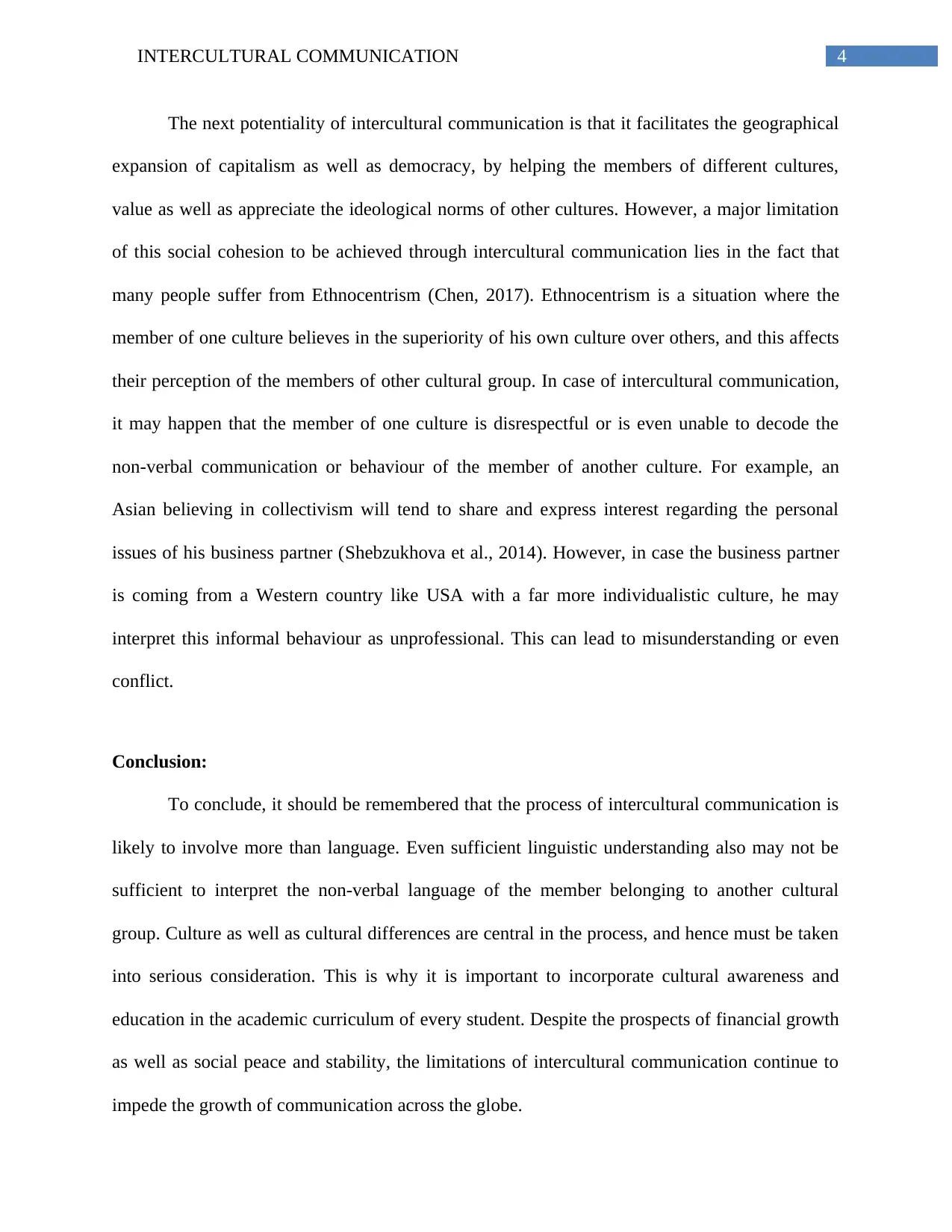
4INTERCULTURAL COMMUNICATION
The next potentiality of intercultural communication is that it facilitates the geographical
expansion of capitalism as well as democracy, by helping the members of different cultures,
value as well as appreciate the ideological norms of other cultures. However, a major limitation
of this social cohesion to be achieved through intercultural communication lies in the fact that
many people suffer from Ethnocentrism (Chen, 2017). Ethnocentrism is a situation where the
member of one culture believes in the superiority of his own culture over others, and this affects
their perception of the members of other cultural group. In case of intercultural communication,
it may happen that the member of one culture is disrespectful or is even unable to decode the
non-verbal communication or behaviour of the member of another culture. For example, an
Asian believing in collectivism will tend to share and express interest regarding the personal
issues of his business partner (Shebzukhova et al., 2014). However, in case the business partner
is coming from a Western country like USA with a far more individualistic culture, he may
interpret this informal behaviour as unprofessional. This can lead to misunderstanding or even
conflict.
Conclusion:
To conclude, it should be remembered that the process of intercultural communication is
likely to involve more than language. Even sufficient linguistic understanding also may not be
sufficient to interpret the non-verbal language of the member belonging to another cultural
group. Culture as well as cultural differences are central in the process, and hence must be taken
into serious consideration. This is why it is important to incorporate cultural awareness and
education in the academic curriculum of every student. Despite the prospects of financial growth
as well as social peace and stability, the limitations of intercultural communication continue to
impede the growth of communication across the globe.
The next potentiality of intercultural communication is that it facilitates the geographical
expansion of capitalism as well as democracy, by helping the members of different cultures,
value as well as appreciate the ideological norms of other cultures. However, a major limitation
of this social cohesion to be achieved through intercultural communication lies in the fact that
many people suffer from Ethnocentrism (Chen, 2017). Ethnocentrism is a situation where the
member of one culture believes in the superiority of his own culture over others, and this affects
their perception of the members of other cultural group. In case of intercultural communication,
it may happen that the member of one culture is disrespectful or is even unable to decode the
non-verbal communication or behaviour of the member of another culture. For example, an
Asian believing in collectivism will tend to share and express interest regarding the personal
issues of his business partner (Shebzukhova et al., 2014). However, in case the business partner
is coming from a Western country like USA with a far more individualistic culture, he may
interpret this informal behaviour as unprofessional. This can lead to misunderstanding or even
conflict.
Conclusion:
To conclude, it should be remembered that the process of intercultural communication is
likely to involve more than language. Even sufficient linguistic understanding also may not be
sufficient to interpret the non-verbal language of the member belonging to another cultural
group. Culture as well as cultural differences are central in the process, and hence must be taken
into serious consideration. This is why it is important to incorporate cultural awareness and
education in the academic curriculum of every student. Despite the prospects of financial growth
as well as social peace and stability, the limitations of intercultural communication continue to
impede the growth of communication across the globe.
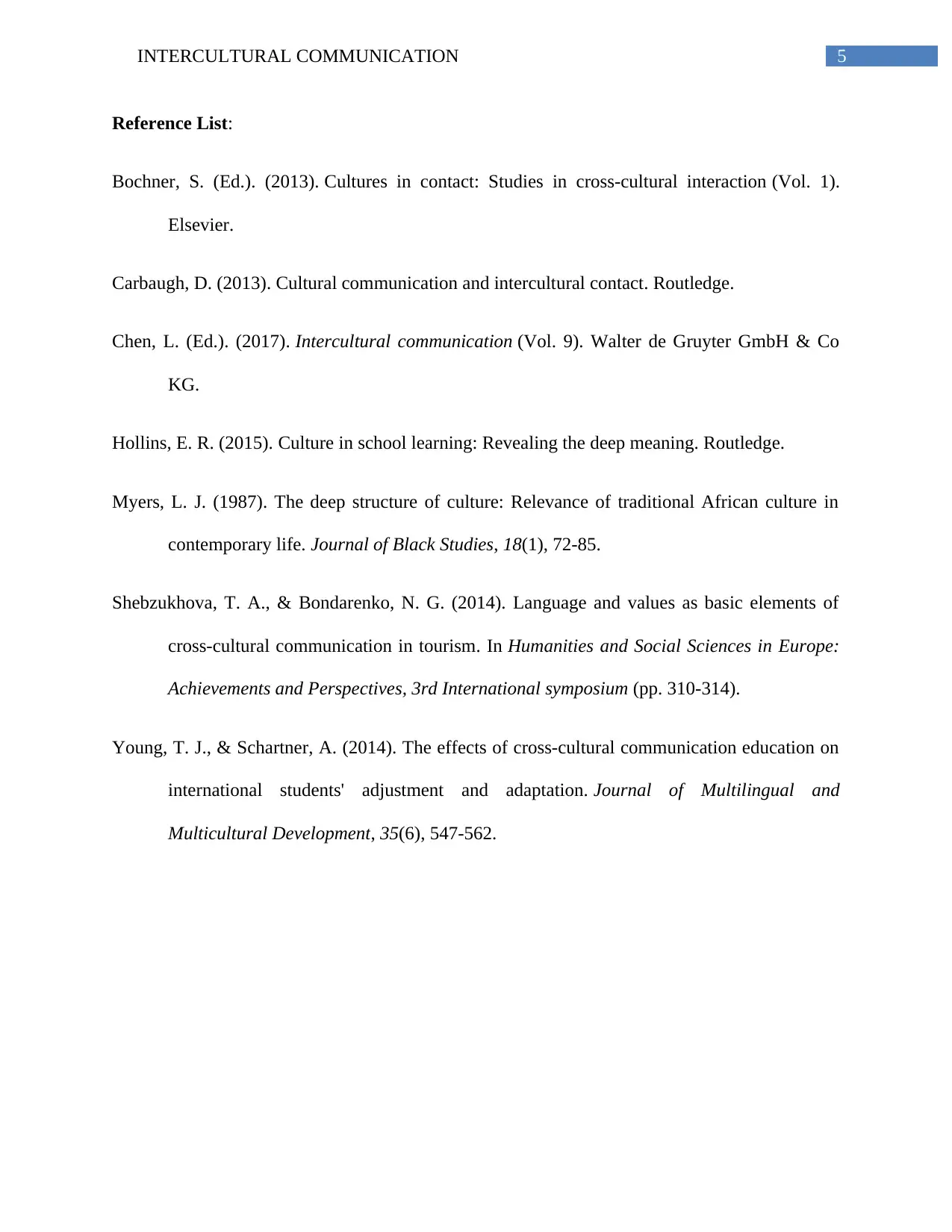
5INTERCULTURAL COMMUNICATION
Reference List:
Bochner, S. (Ed.). (2013). Cultures in contact: Studies in cross-cultural interaction (Vol. 1).
Elsevier.
Carbaugh, D. (2013). Cultural communication and intercultural contact. Routledge.
Chen, L. (Ed.). (2017). Intercultural communication (Vol. 9). Walter de Gruyter GmbH & Co
KG.
Hollins, E. R. (2015). Culture in school learning: Revealing the deep meaning. Routledge.
Myers, L. J. (1987). The deep structure of culture: Relevance of traditional African culture in
contemporary life. Journal of Black Studies, 18(1), 72-85.
Shebzukhova, T. A., & Bondarenko, N. G. (2014). Language and values as basic elements of
cross-cultural communication in tourism. In Humanities and Social Sciences in Europe:
Achievements and Perspectives, 3rd International symposium (pp. 310-314).
Young, T. J., & Schartner, A. (2014). The effects of cross-cultural communication education on
international students' adjustment and adaptation. Journal of Multilingual and
Multicultural Development, 35(6), 547-562.
Reference List:
Bochner, S. (Ed.). (2013). Cultures in contact: Studies in cross-cultural interaction (Vol. 1).
Elsevier.
Carbaugh, D. (2013). Cultural communication and intercultural contact. Routledge.
Chen, L. (Ed.). (2017). Intercultural communication (Vol. 9). Walter de Gruyter GmbH & Co
KG.
Hollins, E. R. (2015). Culture in school learning: Revealing the deep meaning. Routledge.
Myers, L. J. (1987). The deep structure of culture: Relevance of traditional African culture in
contemporary life. Journal of Black Studies, 18(1), 72-85.
Shebzukhova, T. A., & Bondarenko, N. G. (2014). Language and values as basic elements of
cross-cultural communication in tourism. In Humanities and Social Sciences in Europe:
Achievements and Perspectives, 3rd International symposium (pp. 310-314).
Young, T. J., & Schartner, A. (2014). The effects of cross-cultural communication education on
international students' adjustment and adaptation. Journal of Multilingual and
Multicultural Development, 35(6), 547-562.
⊘ This is a preview!⊘
Do you want full access?
Subscribe today to unlock all pages.

Trusted by 1+ million students worldwide
1 out of 6
Related Documents
Your All-in-One AI-Powered Toolkit for Academic Success.
+13062052269
info@desklib.com
Available 24*7 on WhatsApp / Email
![[object Object]](/_next/static/media/star-bottom.7253800d.svg)
Unlock your academic potential
Copyright © 2020–2025 A2Z Services. All Rights Reserved. Developed and managed by ZUCOL.





